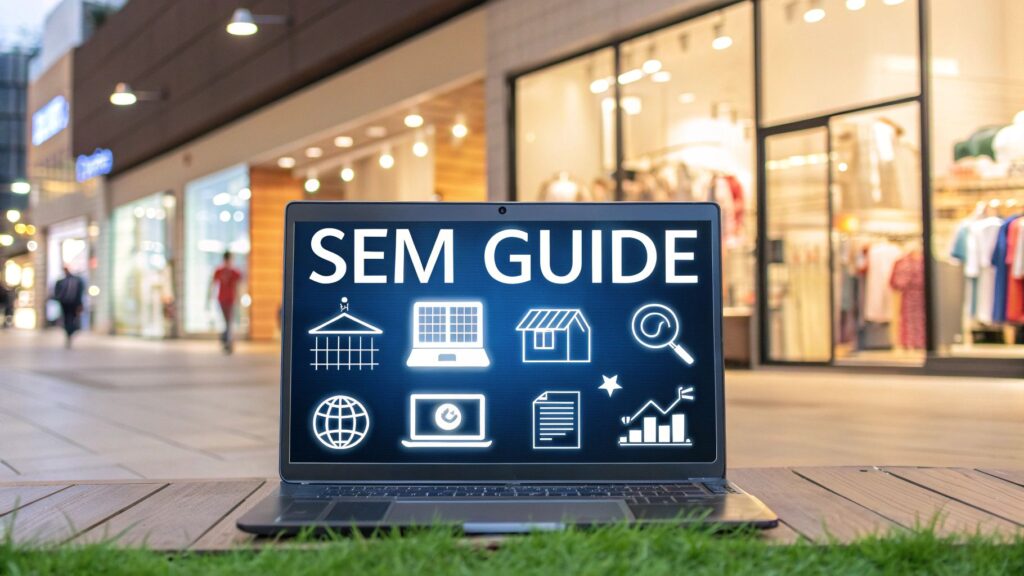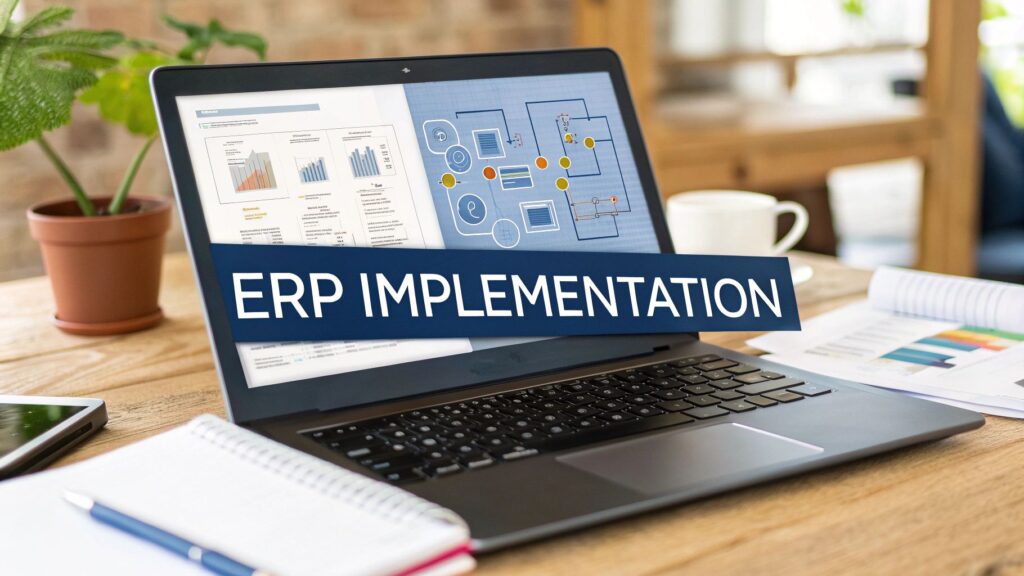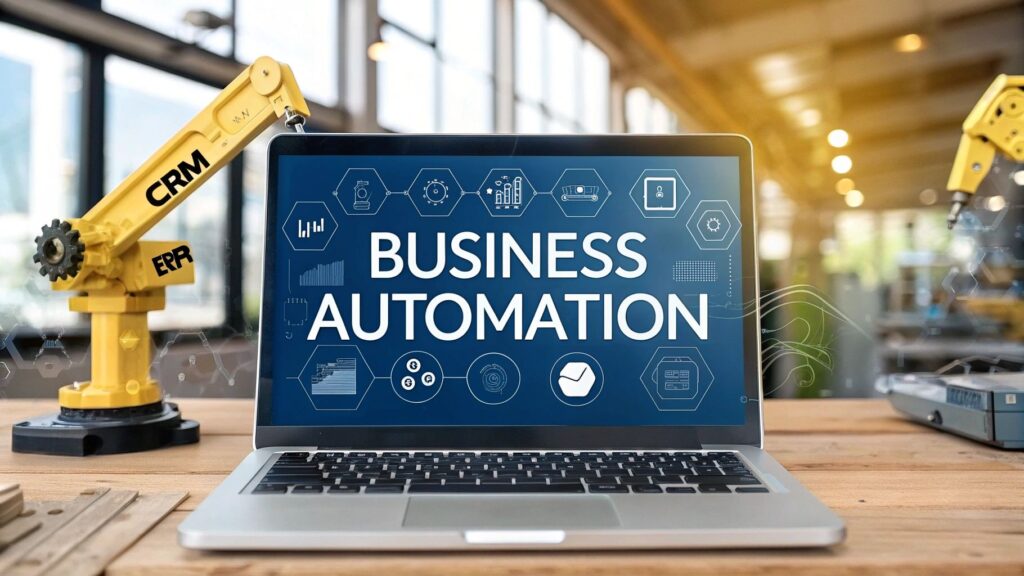Search Engine Marketing, or SEM, is all about getting your website seen on search engine results pages through paid ads. Think of it as the express lane to the top of Google. When someone types in a search for a product or service you sell, SEM puts your business front and center, right when they’re ready to buy.
What Is Search Engine Marketing
Picture a massive, bustling marketplace—that’s a search engine. Millions of people are there every single day, actively searching for answers and solutions. SEM is like renting a premium stall right at the entrance of that market. You’re not waiting for shoppers to stumble upon you; you’re paying to be the first thing they see.
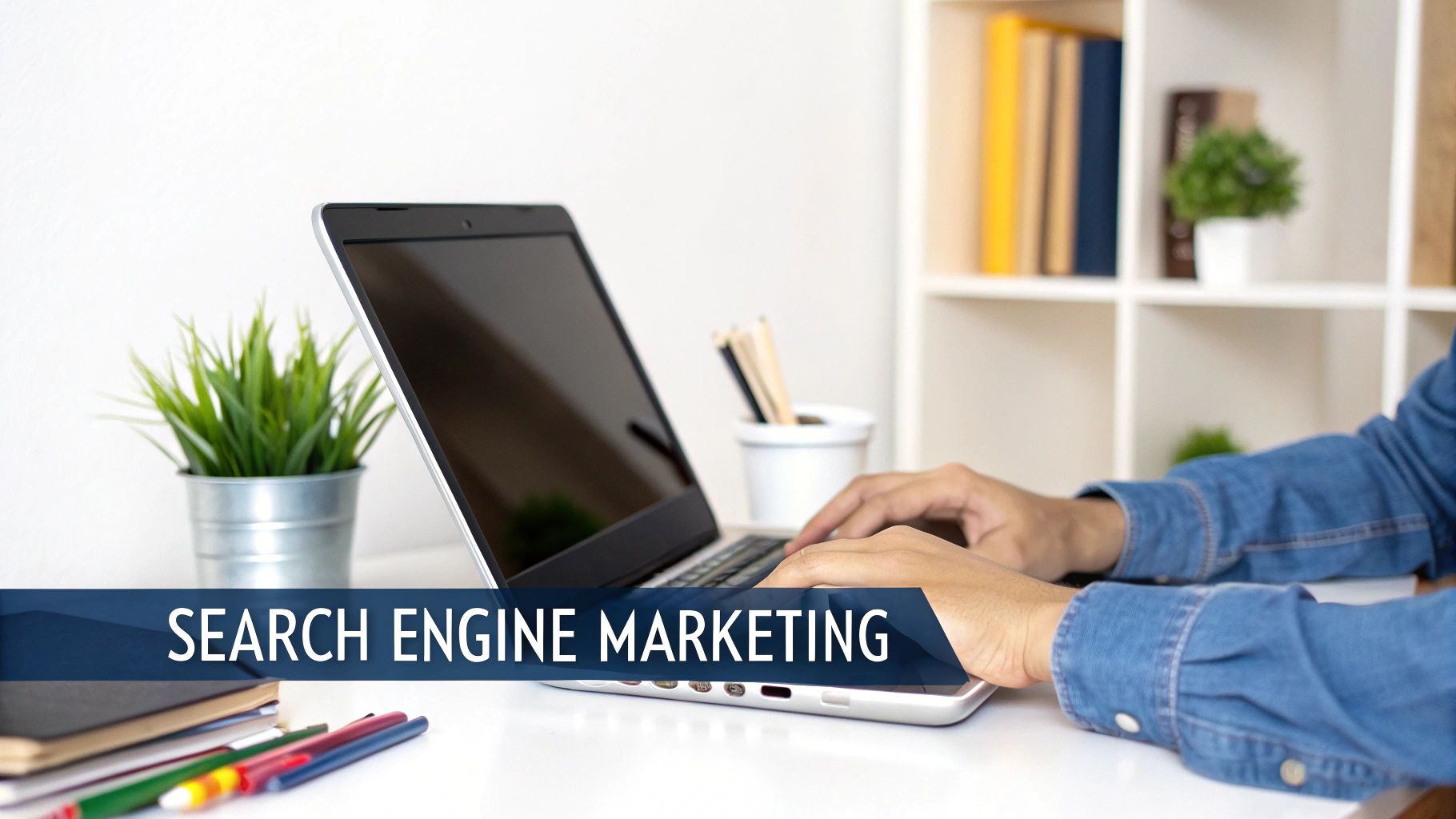
This instant visibility is powered by a system most people know as Pay-Per-Click (PPC). Understanding what is Pay Per Click (PPC) is key to grasping how SEM works. The name says it all: you only pay a fee when someone actually clicks on your ad. This makes it an incredibly targeted and cost-effective way to bring motivated customers to your digital doorstep.
Why It Matters for Business Growth
The real magic of SEM is its ability to connect with people who have high intent. It’s completely different from a social media ad that pops up while you’re scrolling through photos. Search ads are shown to an audience that has already raised their hand and said, “I need help with this,” by typing it into the search bar. Your brand gets to be the immediate solution.
The business impact is huge, especially in booming digital markets. Take the Middle East, for example. The SEM market there was valued at $3.34 billion back in 2021 and is on track to hit nearly $4.79 billion by 2025. The UAE is a major player, expected to account for about 7.48% of that market. It’s a clear sign of just how vital digital advertising has become in the region.
To simplify these ideas, the table below breaks down the core concepts of SEM.
Core SEM Concepts at a Glance
A quick summary of the essential concepts in Search Engine Marketing for immediate clarity and understanding.
| Concept | Brief Description | Primary Goal |
|---|---|---|
| Search Engine Marketing (SEM) | A comprehensive digital marketing strategy using paid tactics to increase search visibility. | Drive immediate, targeted traffic and conversions. |
| Pay-Per-Click (PPC) | An advertising model where advertisers pay a fee each time one of their ads is clicked. | Generate clicks from a specific audience while controlling costs. |
| Search Engine Results Page (SERP) | The page displayed by a search engine in response to a user’s query. | Secure top ad placement for maximum visibility. |
| Keywords | Words or phrases that users type into search engines to find information. | Match ads to relevant user searches to attract high-intent visitors. |
These concepts form the foundation of any successful SEM campaign, working together to turn search intent into business growth.
At its core, SEM bypasses the long wait associated with organic growth. It offers a direct, controllable, and measurable method for generating leads and sales right away.
This is why SEM is such a powerful partner to organic search efforts. While our SEO services work on building your website’s long-term credibility and authority, SEM delivers the quick wins. Using both creates a complete digital strategy—capturing today’s demand while building for tomorrow’s success.
The Pillars of a Modern SEM Strategy
A solid Search Engine Marketing strategy is a bit like building a house—it needs a strong foundation and several key pillars all working together. The absolute core of this structure is Pay-Per-Click (PPC) advertising, which is the engine that drives immediate visibility on search engines. This is how you get your business to show up at the very top of the search results page (SERP) almost instantly.

You can think of PPC as a super-smart digital billboard. But instead of paying a flat rate to show your ad to every single person who drives by, you only pay when someone who is genuinely interested—someone who just searched for what you sell—clicks on your ad to visit your site. It’s this performance-based model that makes SEM so effective and attractive for businesses of any size.
The Engine Room: PPC Advertising
At its heart, PPC runs on an auction system managed by platforms like Google Ads and Microsoft Advertising. The moment a user types in a search, an automated auction kicks off in milliseconds to decide which ads will show up and in what order. But it’s not just about who’s willing to bid the most; it’s a sophisticated calculation that weighs both your bid amount and the quality of your ad.
This model lets you:
- Target Specific Keywords: You get to pick the exact search terms you want your ads to show up for, putting you right in front of users with clear intent.
- Control Your Budget: Set daily or monthly spending caps so you never go over what you’re comfortable with.
- Craft Compelling Ads: Write ad copy and design visuals meant to grab the attention of your ideal customers and earn their click.
The biggest advantage here is speed. While other marketing channels take time to gain traction, a well-run PPC campaign can start sending traffic and leads your way within hours of launch. That kind of immediacy is priceless for new product drops, seasonal sales, or any time you need to make a splash, fast. To build a truly effective strategy, understanding key Search Engine Marketing best practices is a must for long-term success.
The key takeaway here is that PPC offers incredible control. You decide who sees your ads, how much you spend, and what message they get, all while receiving real-time data to track what’s working.
SEM and SEO: The Power Couple of Search
You can’t really have a complete conversation about search marketing without bringing up its close cousin, Search Engine Optimization (SEO). People often mix them up, but SEM and SEO are two different—yet complementary—strategies that are most powerful when used together. They are the two main ways to get your brand seen on a search engine results page.
Here’s a simple way to think about it: SEM is like buying a primetime TV commercial. It gets you immediate attention from a huge audience, right when you want it. SEO, on the other hand, is like earning a glowing review in a top magazine. It takes time and consistent effort to build that kind of reputation, but once you have it, it brings in credible traffic for years to come with no direct cost for each visitor.
Here’s a quick breakdown of how they differ:
| Feature | Search Engine Marketing (SEM) | Search Engine Optimization (SEO) |
|---|---|---|
| Placement | Paid ad slots, usually at the very top of the SERP. | Organic (non-paid) results, which appear below the ads. |
| Time to Results | Immediate. Traffic can start flowing as soon as the campaign is live. | Long-term. It can take months to see significant results. |
| Cost | You pay for every click or impression (e.g., Cost-Per-Click). | The traffic itself is “free,” but it requires investment in content, site fixes, and building links. |
| Control | A high degree of control over targeting, ad copy, and budget. | Less direct control. You can influence your rankings but don’t own the spot. |
In the end, a truly dominant search presence doesn’t choose one over the other; it uses both. SEM delivers quick wins and invaluable keyword data, while SEO builds the sustainable, authoritative foundation needed for long-term growth. They are two sides of the same coin, working in harmony to make sure your business is visible from every possible angle in the search results.
How the Ad Auction Actually Works
Ever wondered how Google decides which ads to show you at the top of the page? Many people think it’s a simple case of the highest bidder winning. While your budget is definitely part of the story, the real process is much smarter and, frankly, more interesting.
Every single time someone hits “search,” a lightning-fast, automated event called the ad auction kicks off. This isn’t your typical auction where cash is king. Instead, search engines are obsessed with giving users the most relevant and helpful results—and that includes ads.
To do this, they don’t just look at who’s willing to pay the most. They use a formula to calculate something called Ad Rank.
Think of it like a figure skating competition. One skater might have a flashy, expensive costume (the bid), but if their performance is sloppy and they fall on the ice, they won’t score well. Another skater with a simpler costume who delivers a flawless, captivating routine (the quality) is going to win over the judges and the crowd. It’s the combination of presentation and skill that takes home the gold.
The Winning Formula: Ad Rank
The advertiser with the highest Ad Rank wins the auction, not always the one with the deepest pockets. This is a crucial concept because it levels the playing field. It means a small business with a fantastic, relevant ad can absolutely compete with a huge corporation throwing money around.
The formula itself is pretty straightforward:
Ad Rank = Maximum Bid x Quality Score
- Maximum Bid: This is the most you’re willing to pay when someone clicks your ad. It’s the “money” part of the equation.
- Quality Score: This is Google’s rating of your ad’s overall quality and relevance, scored from 1 to 10. It looks at your keywords, the ad itself, and the page people land on after clicking. This is the “skill” part.
This visual shows how that auction leads to a click and, hopefully, a customer.
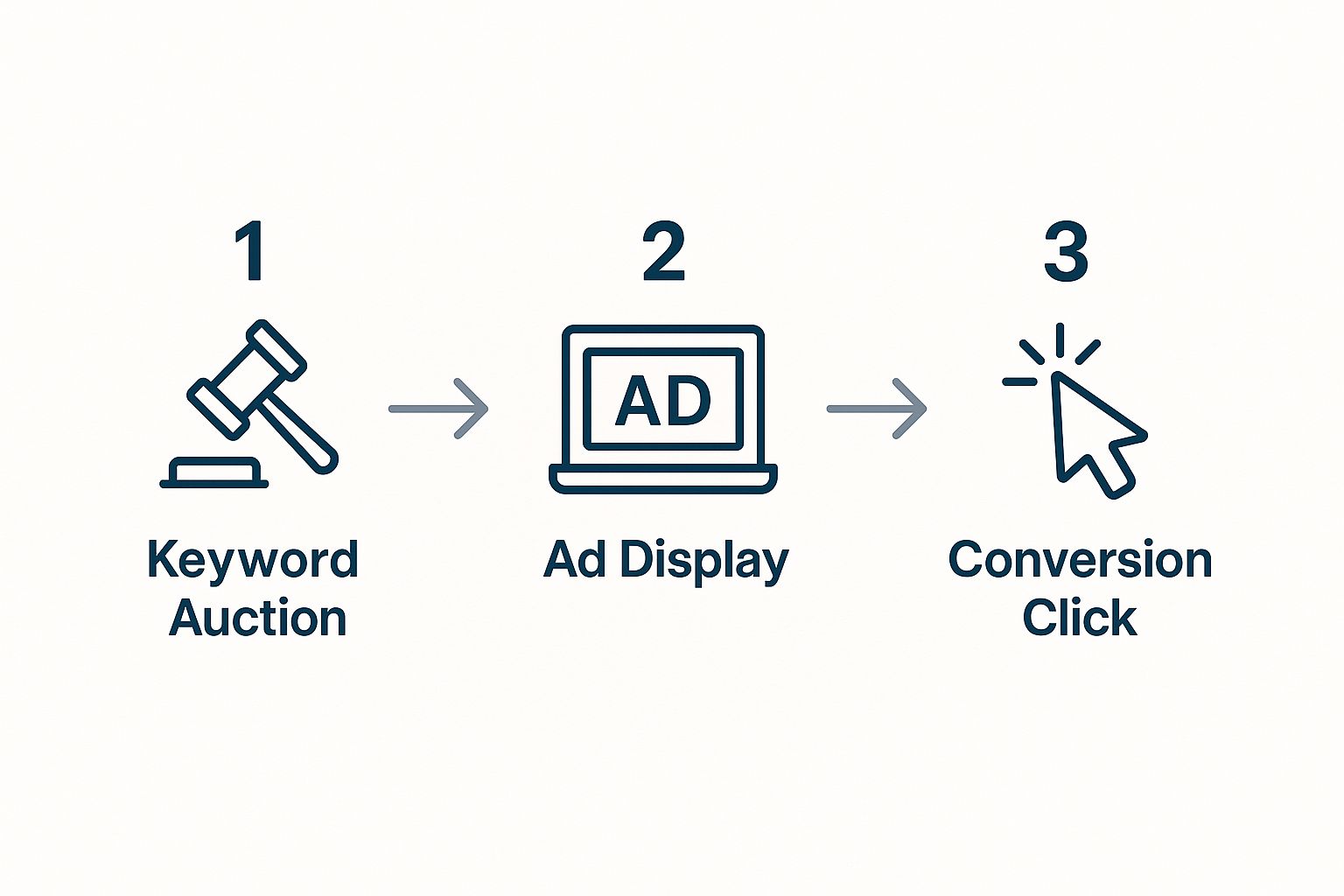
As you can see, the behind-the-scenes auction is what determines who gets that valuable visibility, guiding a user from their initial search to a potential sale on your site.
Breaking Down the Quality Score
Your Quality Score is the secret weapon for running efficient ad campaigns. A high score is your signal to Google that your ad is a perfect match for what someone is searching for. The reward? Better ad positions at a lower cost.
Google looks at three main things to calculate this score:
- Expected Click-Through Rate (CTR): Based on past performance, how likely is someone to actually click your ad when they see it?
- Ad Relevance: Does your ad copy directly relate to the search term? If someone searches for “running shoes for men,” your ad should talk about men’s running shoes, not just “great footwear.”
- Landing Page Experience: What happens after the click? Your landing page needs to be relevant, load quickly, and be easy to use. It must deliver on the promise your ad made.
Let’s look at a quick example. Two online stores, “Quick Kicks” and “Super Shoes,” are bidding on the keyword “women’s trainers.”
| Competitor | Maximum Bid | Quality Score | Ad Rank (Bid x Score) |
|---|---|---|---|
| Quick Kicks | $2.00 | 10 | 20 |
| Super Shoes | $3.00 | 5 | 15 |
Even though Super Shoes is bidding 50% more per click, Quick Kicks wins the better ad spot. Their killer Quality Score—probably thanks to a super-relevant ad and a great landing page—gives them a higher Ad Rank.
It proves that a smarter strategy really can beat a bigger budget. And in a competitive e-commerce world, that matters more than ever. This is especially true in fast-growing markets like the UAE, where e-commerce is projected to hit $80.3 billion by 2029. You can read more about the Middle East marketing technology landscape and its rapid expansion to see just how quickly things are evolving.
Choosing the Right SEM Platform
Deciding where to put your advertising dollars is a huge step in building any solid SEM strategy. Every platform opens the door to a different audience and comes with its own set of tools. The right choice really boils down to your specific business goals, who you’re trying to reach, and what your budget looks like.
For most businesses just starting out, the path is pretty clear. You start with the undisputed king of search.
The launchpad for almost every SEM campaign is Google Ads. Its dominance isn’t just talk; the numbers back it up. In the UAE, for instance, Google has a staggering 96.1% of the search engine market share. This isn’t just a lead; it’s a near-total command of the market. You can dig into the UAE’s search engine landscape at StatCounter to see the data for yourself.
What does that mean for you? If your customers are online, they’re almost certainly on Google. This sheer volume makes Google Ads the go-to platform for reaching the largest possible audience of people ready to buy.
Getting Started with Google Ads
Think of Google Ads less as a single tool and more as a complete advertising toolkit, with different options designed for different jobs. Knowing the main campaign types is the first step to making the platform work for you. A smart, well-built Google Ads campaign can be an absolute game-changer for bringing in the right kind of traffic.
Here are the most common campaign types you’ll encounter:
- Search Campaigns: These are the classic text ads you see at the top of Google search results. They’re perfect for grabbing the attention of people who are actively looking for exactly what you sell.
- Display Campaigns: Ever see a banner ad on your favorite blog or news site? That’s a display ad. They show up across a massive network of websites and apps, making them great for building brand awareness or reminding past visitors about your business.
- Shopping Campaigns: If you run an e-commerce store, these are a must. Shopping ads put your products—picture, price, and all—right in the search results. It’s a powerful visual pitch that grabs attention instantly.
- Video Campaigns: These ads run on YouTube and other video sites in Google’s network. They’re fantastic for telling a story and connecting with your audience through engaging video content.
Each format has a unique purpose, giving you the flexibility to do everything from capturing immediate sales to building a brand that people remember for years.
Exploring Alternatives like Microsoft Advertising
While Google wears the crown, it’s not the only name in the game. Microsoft Advertising (you might remember it as Bing Ads) is a fantastic, and often underestimated, alternative. Its ads are shown across the Microsoft Search Network, which includes Bing, Yahoo, and AOL, giving you a chance to connect with a different segment of the market.
So, why bother with a platform that has a smaller market share? It comes down to two things: a unique audience and better bang for your buck.
Microsoft Advertising tends to reach an older, more affluent crowd that might not be as glued to Google. This audience can be pure gold for businesses in finance, automotive, and B2B services.
On top of that, there’s generally less competition fighting for ad space on the Microsoft network. This often means the Cost Per Click (CPC) can be quite a bit lower than what you’d pay on Google Ads. For businesses on a tight budget, this is huge. It means your money goes further, potentially leading to a much higher Return On Ad Spend (ROAS). It’s a savvy move to find valuable customers your competitors are completely ignoring.
The table below breaks down the key differences to help you see where each platform shines.
Comparing Google Ads and Microsoft Advertising
This side-by-side look at the two leading SEM platforms can help you decide where to best allocate your advertising budget.
| Feature | Google Ads | Microsoft Advertising (Bing) |
|---|---|---|
| Reach & Volume | Massive global reach, highest search volume. | Smaller but significant reach, especially in North America. |
| Audience | Broad, diverse demographic covering nearly all user types. | Tends to be older, more affluent, and slightly more B2B-focused. |
| Competition | Extremely high across most industries. | Lower competition, which can lead to better ad positions. |
| Cost Per Click (CPC) | Generally higher due to intense competition. | Often lower, offering potentially better ROAS. |
| Network | Google Search, YouTube, Gmail, and millions of partner sites. | Bing, Yahoo, AOL, and partner networks like DuckDuckGo. |
| Features | The first to release new features and ad formats. | Often follows Google’s lead but has unique targeting options. |
Ultimately, a truly great SEM strategy isn’t about choosing one or the other. It’s often about using both. You can start with Google Ads to capture the biggest slice of the pie, then expand to Microsoft Advertising to tap into a different audience at a lower cost. This creates a more balanced and resilient approach to your search marketing.
Key Metrics for Measuring SEM Performance
So, you’ve launched your SEM campaign. Now what? Just letting it run without checking in is like driving a car blindfolded. You’re definitely moving, but you have no idea if you’re headed for a wall or the finish line. To know what’s actually working, you need to speak the language of your campaigns, and that language is data.
These key metrics aren’t just numbers on a screen. They tell a story. They reveal how people are responding to your ads, what’s grabbing their attention, and most importantly, whether your ad budget is bringing in real business. By getting comfortable with a few core metrics, you can stop just spending money on ads and start investing it strategically.
Click-Through Rate and Cost Per Click
Let’s start with the basics: Click-Through Rate (CTR) and Cost Per Click (CPC). These two metrics are your frontline indicators, giving you a quick snapshot of your ad’s health and efficiency.
CTR is simple—it’s the percentage of people who saw your ad and were compelled enough to click it. Think of it as a direct measure of your ad’s appeal. A high CTR is a great sign that your ad copy and keywords are hitting the mark with your audience.
CTR = (Total Clicks / Total Impressions) x 100
Then there’s CPC, which tells you exactly what you paid for each of those clicks. This is all about budget management. A lower CPC means your advertising dollars are stretching further, bringing more potential customers to your site for the same cost.
- Why They Matter: A strong CTR often leads to a better Quality Score from Google, which can actually lower your CPC. And a low CPC means you’re running a tight, cost-effective campaign. They’re a powerful duo.
Conversion Rate
Clicks are nice, but they don’t keep the lights on. The metric that truly ties your campaign to your business goals is the Conversion Rate. A “conversion” is any meaningful action a user takes after clicking your ad—making a purchase, filling out a contact form, or signing up for a demo.
Your conversion rate is the percentage of clicks that turned into one of these valuable actions. This is where your ad spend starts to connect to real results. A high conversion rate shows that your landing page delivered on the promise your ad made, guiding visitors smoothly to the next step.
A campaign with a great CTR but a terrible conversion rate is a classic red flag. It usually points to a disconnect. Maybe the ad promised a discount that the landing page didn’t mention, or the page itself was confusing and hard to navigate.
Nailing this metric is the key to optimizing your entire customer journey. Many businesses turn to integrated platforms to connect the dots from ad click to final sale. For instance, professional HubSpot marketing services can help you track and improve this entire process from start to finish.
Return On Ad Spend
Finally, we get to the bottom line—the metric that makes CFOs and CEOs sit up and pay attention: Return on Ad Spend (ROAS). It answers the most critical question of all: “Are we making money from these ads?”
ROAS measures the total revenue you earn for every single dollar you spend on an ad campaign. It strips away all the vanity metrics and focuses purely on profitability.
The formula is straightforward:
ROAS = (Total Revenue from Ads / Total Ad Cost)
For example, if you spend $1,000 on a campaign and it brings in $5,000 in new sales, your ROAS is 5. That means you’re generating $5 in revenue for every $1 you put in. This is the kind of clarity that empowers you to make smart decisions—knowing exactly which campaigns to scale up and which ones to cut.
Here’s the rewritten section, designed to sound completely human-written:
What Are the Real Business Benefits of SEM?
Sure, SEM is great for getting quick traffic, but its true value runs much deeper. It’s a powerful strategic tool that delivers something most other marketing channels can’t: speed.
Think about it. When you launch a new product or a flash sale, you need eyeballs on it now, not next quarter. With SEM, you can spin up a campaign and get your ads in front of people actively searching for what you offer, sometimes in a matter of hours. That kind of agility is exactly what you need to jump on market opportunities the second they appear.
Laser-Focused Targeting: Finding Your Perfect Customer
One of the biggest wins with SEM is its incredible targeting. You’re not just throwing ads out there and hoping for the best. Instead, you can pinpoint the exact person you want to talk to, right at the moment they’re looking for a solution. It’s like being able to find your ideal customer in a massive crowd and start a conversation.
You can really narrow down your audience with some powerful levers:
- Search Intent: Go after people based on the specific words they’re typing into the search bar. This is your chance to catch them when their interest is highest.
- Geographic Location: Want to target customers in a specific city, zip code, or even within a few miles of your shop? You can do that.
- Demographics: You can also filter by details like age, gender, parental status, and more to make sure your message hits home.
This precision means you stop wasting money on people who will never buy from you. Every dollar goes toward reaching someone who is far more likely to become a customer.
Think of SEM as more than just an ad platform—it’s one of the best real-time market research tools you can get. The data gives you a direct line into what your customers are thinking and doing.
Using Data to Steer Your Business Strategy
Every click, impression, and conversion in your SEM campaigns tells a story. This data is pure gold. It shows you which keywords are actually driving sales, what ad copy connects with your audience, and how search trends shift throughout the year.
This constant feedback is incredibly valuable. The insights you pull from your SEM reports can shape everything from your website’s content and product development to your entire business strategy. It turns your marketing efforts into an engine for smart, data-backed growth, proving that SEM is a must-have for any serious business today.
Frequently Asked Questions About SEM
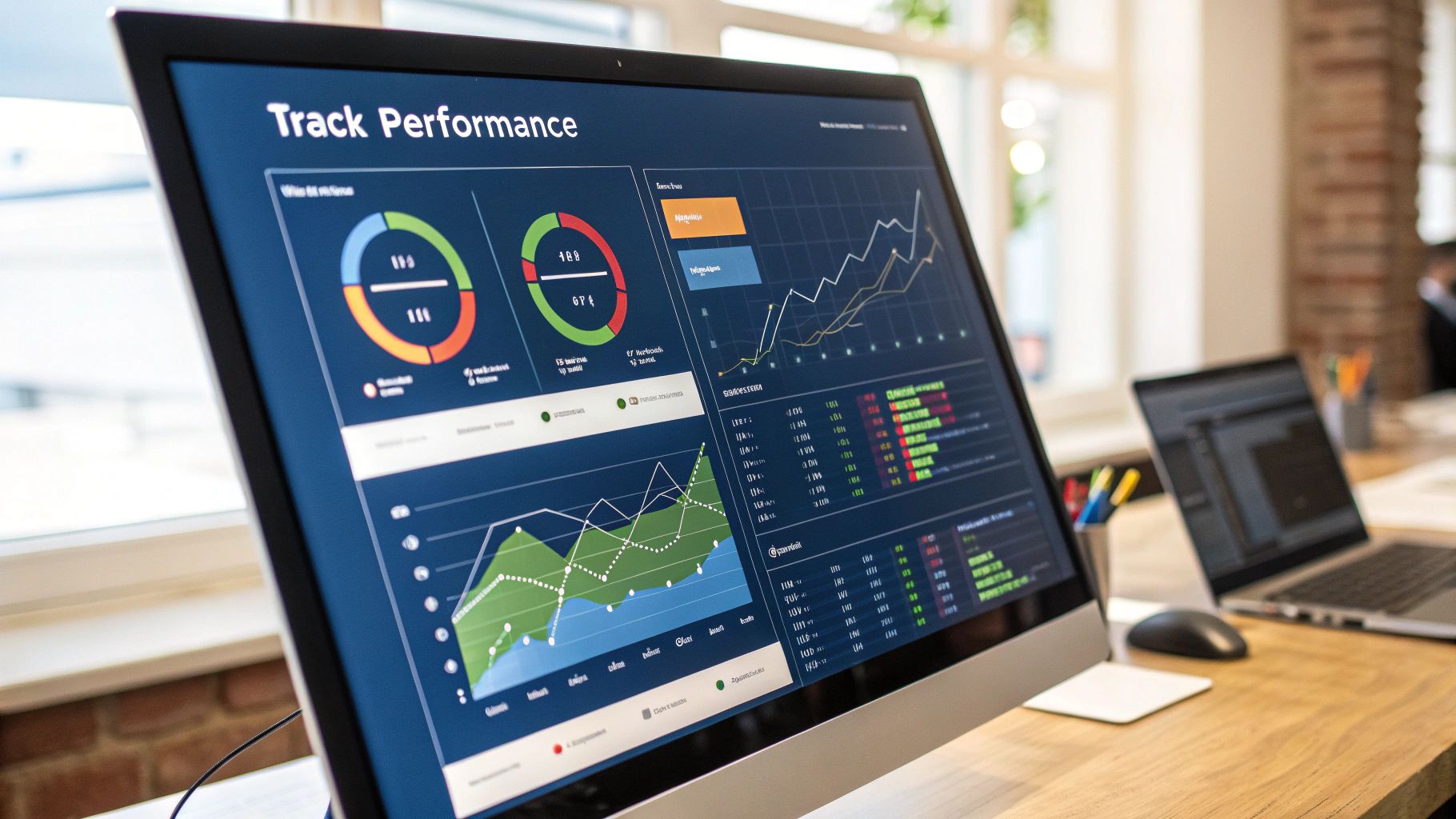
When you’re first digging into search engine marketing, a few questions always pop up. It’s totally normal. Getting straight answers is the first step to building an SEM strategy you can feel good about, so let’s clear up some of the most common ones.
Right off the bat, the biggest head-scratcher for most people is how SEM and SEO relate to each other. It’s simpler than it sounds. Think of them as two different lanes on the same highway, both heading toward the goal of getting you seen on Google.
- SEM (Search Engine Marketing) is the express lane—the paid route. You pay to place your ads at the very top of the search results for instant visibility.
- SEO (Search Engine Optimization) is the scenic route. You earn your spot organically by building a great website and creating high-quality content. It takes time, but the payoff is long-term trust and authority.
They really are a power couple. SEM gets you traffic and data right now, while SEO builds a foundation for sustainable, free traffic down the road.
How Much Should a Small Business Budget for SEM?
This is the million-dollar question, isn’t it? And the honest answer is: it depends. Your budget really hinges on how competitive your industry is and what you’re trying to achieve.
For most small businesses diving into a platform like Google Ads, a starting budget of $500 to $2,000 per month is a solid place to begin.
That’s usually enough to get the ball rolling, run some tests, and start gathering real data on what resonates with your audience. As you see a positive return on ad spend (ROAS), you can confidently increase your investment.
The best way to think about your initial budget is not as a cost, but as an investment in learning. You’re paying to discover what your customers are actually looking for and what makes them click.
How Quickly Can I Expect to See Results?
Here’s where SEM really flexes its muscles. While other marketing efforts can take months to gain traction, the impact of search engine marketing can be incredibly fast.
Once your campaign gets the green light, your ads can show up in search results within minutes. You can literally start seeing clicks and traffic on day one.
Now, turning that traffic into solid business results—like phone calls and sales—takes a little more time. Give it a few weeks for the ad platform’s algorithm to do its thing and for you to tweak your campaigns based on what the early data tells you. Most businesses start seeing consistent, tangible results within the first 1-3 months.
At Invocom, we live and breathe data-driven SEM. We specialize in building campaigns that don’t just get clicks—they deliver real, measurable growth. Let’s build a strategy that puts you in front of the right customers and moves your business forward. Learn more about our digital solutions at https://invocom.me.

